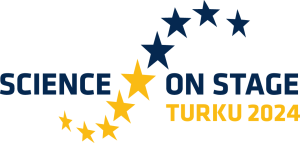Projects that contribute to the achievement of the 17 Sustainable Development Goals.
(S1) “Notification ΙΟΤ device – alarm in case of out of bounds emotional state or heart rate and simultaneously detected change in emotional state Students call it ‘Lie Detector'” and “Traffic light with priority on ambulance – Supersonic horn that also works”, N. Kourakis (GR)

Institution: Gel Vamou
“A. Initially, the goal was to create a notification or alarm device when heart rates deviate from normal limits, which we built. At the same time, a playful mood to consider building a lie detection device with sensors that clip onto an arduino nano became the reason to create this project that was two in one.
B. Observing on a school bus trip, on a main street of our city, an ambulance stopped in front of us in a long line of cars, with traffic lights in front and at the sound of the ambulance siren, the cars could not make way unless the traffic lights stayed green for a long time, our idea was born: to use an ultrasonic signal from the ambulance to activate green for it and red for the others.”
(S2) “The Village of the Future” – An Edu Escape Game for lessons in the upper school, A. Neuhaus & S. Cornelius (DE)

Institution: Otto-Hahn Gymnasium Nagold & Technoseum Mannheim
Subjects: Physics, technology
The “Village of the Future” is an edu escape game for high school students on the topic of renewable energies. The aim of the company Village of the Future is to build up an energy supply from renewable energies for small villages in order to make them self-sufficient in energy. The commissioning of the village network has to be done on the day of the soccer World Cup. Unfortunately, the colleague responsible for the commissioning is ill and all important information is protected by riddles due to fear of climate deniers. To solve the riddles, the students experiment with solar cells, take measurements, evaluate characteristic curves and solve riddles about wind turbines and biomass.
(S3) A cup of coffee: coffee waste as fertilizer, S. Zoboli & G. Messori (IT)
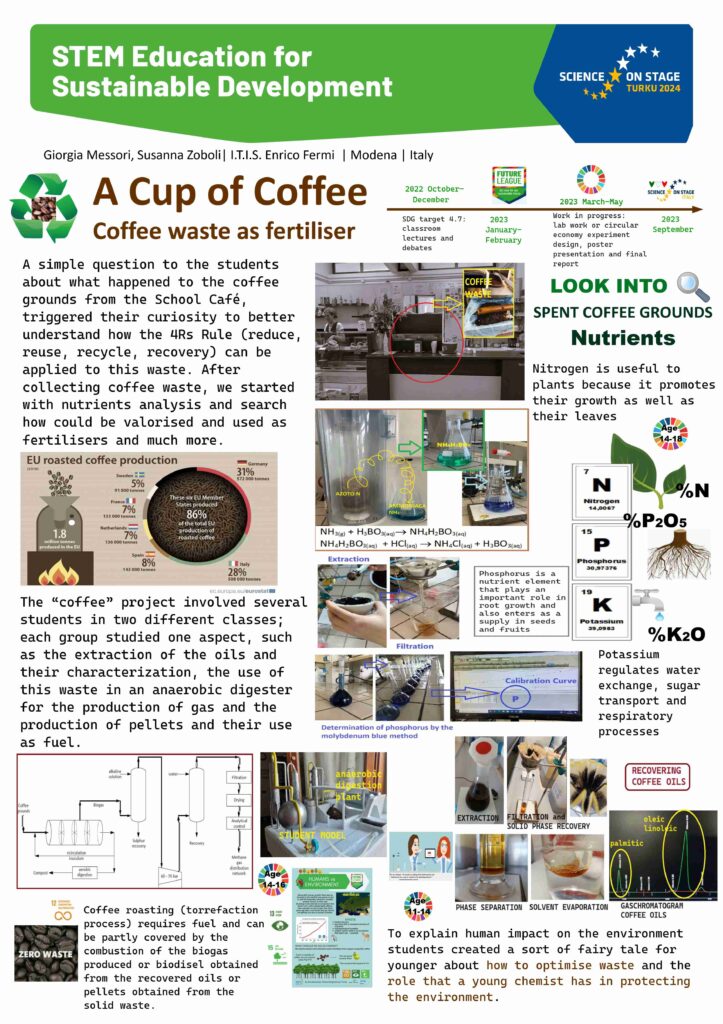
Institution: Istituto Tecnico Industriale Statale Enrico Fermi
Subjects: Physics, biology, chemistry, mathematics
A simple question about what happened to the coffee grounds from the school bar sparked the pupils’ curiosity to understand how 4R’s rule (reduction, reuse, recycling, energy recovery) could be applied to this waste. After collecting coffee waste on a daily basis, we began to analyse it and look for ways to enhance and use it as fertiliser. The ‘coffee’ project involved several students in two different classes and the research developed along two main lines:
The analytical study of the nutrient content of the waste to be reused as fertiliser and the design of the plant, an anaerobic bio-digester producing gas and pellets and the extraction of the coffee oils and their characterisation.
(S4) Achieving the Sustainable Development Goals through STEM teaching, D. S. Ríos (ES)

Institution: La Inmaculada School
Subjects: Physics, biology, chemistry, technology
The initiative seeks to apply the scientific knowledge from the educational STEM curriculum, to explore various SDGs through experimentation and inquiry. This project specifically focuses on 9 of the 17 SDGs, while indirectly addressing the remaining 8. The approach is twofold: encouraging students to understand each goal, pondering its significance, and connecting it with their daily lives, thereby motivating them to engage in small, impactful actions. Also, through hands-on laboratory experimentation, students explore the effects of certain human behaviours on the planet and engage in experiments or small-scale projects aimed at achieving these global goals.
(S5) Back to the future, J. A. P. Rodrigues & L. Carreiró (PT)

Institution: Agrupamento de Escolas de Nelas & Agrupamento de Escolas de Santa Comba Dão
Subjects: Physics, chemistry
This project aims at illustrating the evolution of energy production and usage from the earliest times to the present day. Starting with the artefacts used to lift water by hand, through to the first steam engine and Watt’s engine, culminating in sustainable suggestions for renewable energy prototypes. The activities were carried out with students, using a STEM approach that demonstrates the importance of science for technological and social development, while maintaining a focus on energy sustainability. A historical perspective was used where a return to the initial energy sources (sun, water, and wind) seemed inevitable.
(S6) Biochar and bokashi in education, K. Pöyskö & T. Ullgren (FI)
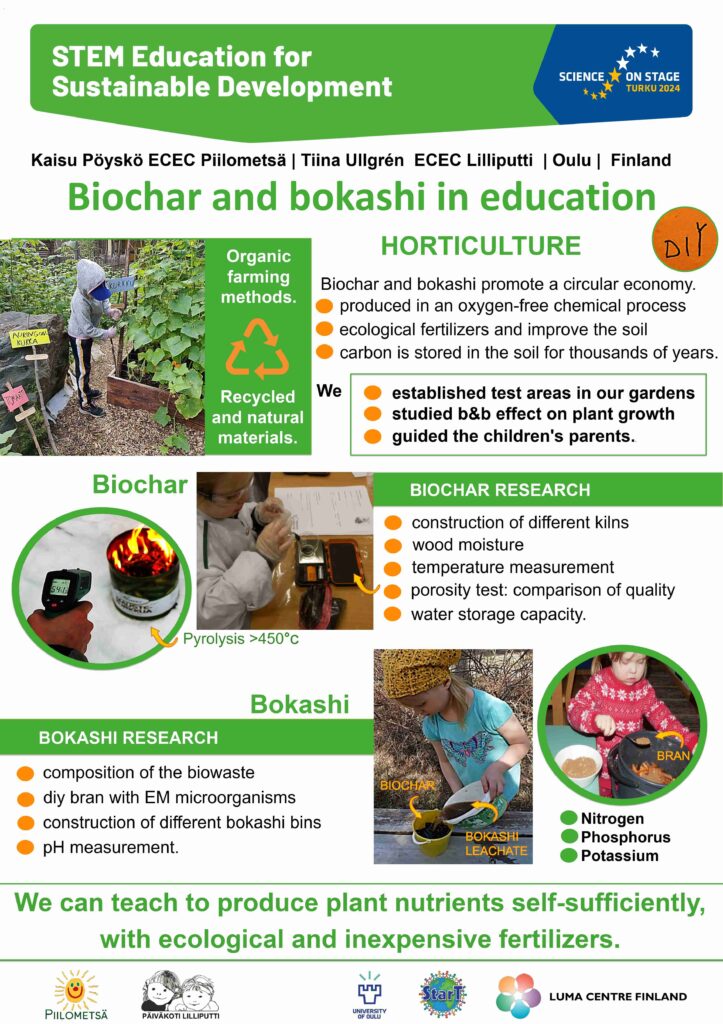
Institution: Päiväkoti Lilliputti & Päiväkoti Piilometsä
Subjects: Physics, chemistry, mathematics, science
Biochar and bokashi can be used to promote plant growth and improve soil. We will teach you how to make biochar and bokashi containers from recycled materials and how to study the properties of biochar and bokashi. Biochar is produced through pyrolysis. You can measure the combustion temperatures and wood moisture during the process. You can study the porosity of biochar, do plant tests and measure the pH content and water consumption. The bokashing process turns bio-waste into mulch. It compares the effect of biowaste on the composition of the bokashi mulch and liquid. You can find out pH, temperature, mulching time, and the effect of bokashi on plant growth.
(S7) Bioeconomy for a sustainable future, S. Esendemir (TR)
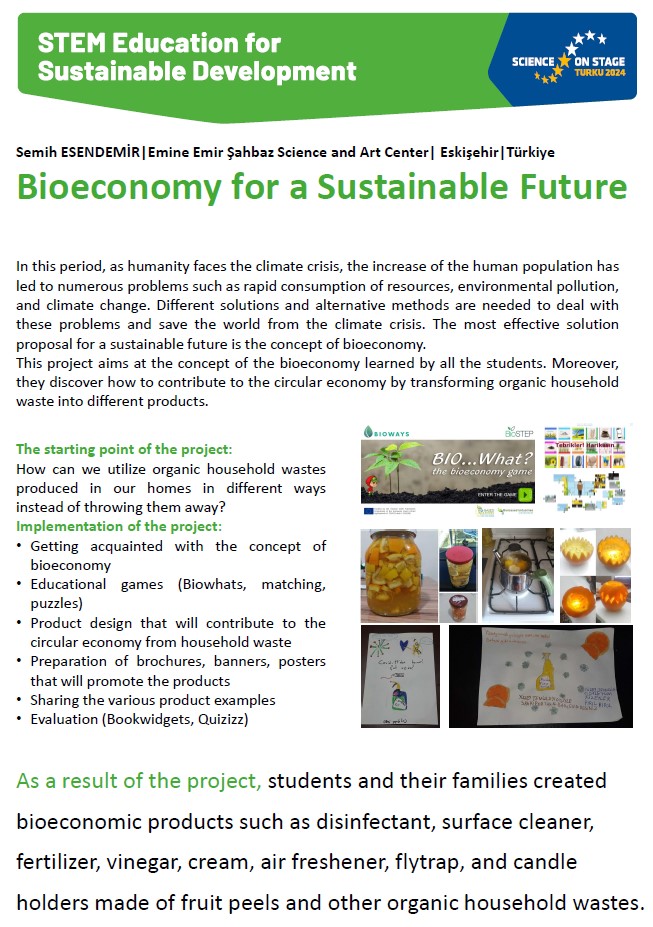
Institution: Emine Emir Sahbaz Science and Art Center
Subjects: Biology, chemistry, science
In this project, it is expected that students will learn the concept of bioeconomy and increase their awareness of bioeconomy. Students produced usable bioeconomic products from organic waste, supported by videos, online materials and educational games. They played a role in the dissemination of bio-products in the society by testing their products and preparing flyers, posters and advertisements about their products. As a result of the students’ feedback and the products they created, it shows that they have gained environmental awareness and that the project has achieved its purpose.
(S8) Climate change – local solutions to global challenges, E. H. Enoksen (NO)

Institution: Edvard Munch videregående skole
Subjects: Physics, technology, science, research studies
All over the world, the effects of climate change are felt. Yet, solutions to stop or mitigate the effects of climate change may seem small and inadequate. Through this project, students from Kyrgyzstan, Slovakia, Norway and South Africa will independently research the effects of climate change and the measures that are taken to stop or mitigate these effects in their country. Students will then meet in an online conference, learning about effects of and solutions to climate change from each other. Seeing multiple local solutions will showcase the power of local solutions and thus empower students to believe that action against climate change is both possible and important.
(S9) Create mini ecosystems with students, G. van der Veer (NL)

Institution: Het Stedelijk (Innova)
Subjects: Science, ecology, sustainability, practical skills, plant sciences
During this project, students will design a mini ecosystem, after which they will put it together themselves. A recycled glass jar is filled with stones, sand, plants and optional other organisms. All kinds of things can then be investigated using this living example of a micro ecosystem. Moreover, it gives students a view of the world by making an ecosystem very small. Lessons about nature conservation and nature management can be given.
If the mini ecosystem is under the right conditions, it will remain alive for years.
Learn by doing! Create a mini ecosystem!
(S10) Creating a Sorting Garbage Robot, D. Doskochynskyi (UA)

Institution: Lyceum after Ivan Puluj
Subjects: Computer science/ICT/IT, ecology
An important aspect in overcoming the problem of pollution on our planet is solving the problem of sorting garbage.
Together with my pupils, we investigated the problem of sorting garbage and created a robot garbage sorter using robotics. It was a school-wide project named Sorting garbage – saving the planet. Another part of my project is creating the Hydraulic Press for Garbage Sorting, using secondary raw materials. Together with my students we also created the project-game “Correct Sorting” . An important task for the students of our school is to have a public position and take an active part in the life of the school, helping to save the planet from pollution with their small actions.
(S11) A Congress for the future – independently organised by children for younger children, P. Carbon (DE)

Institution: Heinrich-Mann-Schule
Subjects: STEM
What is climate change? What are the consequences? And: What can I / we personally do about it?
Sixth graders answered these questions in a committed, motivated and innovative way. They passed on their knowledge from the classroom to more than 90 elementary school students in a future congress that they planned entirely themselves, and got the “”next generation”” to take action. The workshops they developed and conducted themselves covered insect protection, healthy eating, glass recycling, plastics, fair trade, ice melting, renaturation, and dream playground or school.
The students also got their families, school administrators and politicians on board and presented them the results of the congress.
(S12) Defining Soil pH Level in the Classroom Environment, M. Makaridze (GE)

Institution: LEPL Gori Municipality Village Tiniskhidi Public School
Subjects: Biology, chemistry
Our school’s pupils bought cypress saplings with the money received by handing over waste paper and planted them. The seedlings grew slower than expected. Therefore, we decided to study what kind of soil cypress needs and then act accordingly. One of the important characteristics of soil is its pH value. We decided to study it: took a sample of the soil, dissolved and filtered it, titrated it with alkali, measured the acidity of the filtrate with a pH-meter and litmus paper. With obtained result, the of soil’s pH≈6.5. For cypresses the optimum pH≈6. Therefore, we reduced the acidity of the soil with a sulfur suspension. As a result, the growth process of seedlings was noticeably accelerated.
(S13) Electricity from sea waves, L. Dimitriou (GR)

Institution: Laboratory Centre of Physical Sciences of Egaleo
Subjects: Physics, technology
This project aims to exploit the mild and renewable source of energy produced by the waves of the sea. The construction of the experimental arrangement of the project is carried out with materials available in a school laboratory. Through this, ripples are created in the water. The waves set a plastic float in motion, and with it the magnet to which it is connected by a metal rod. The movement of the magnet creates an inductive voltage in the coil. The energy from the waves is converted into kinetic energy in the magnet and then into electrical energy in the coil, which lights an LED or charges a capacitor.
(S14) Environmental Education Path, J. Gustafsson & H. Reima (FI)
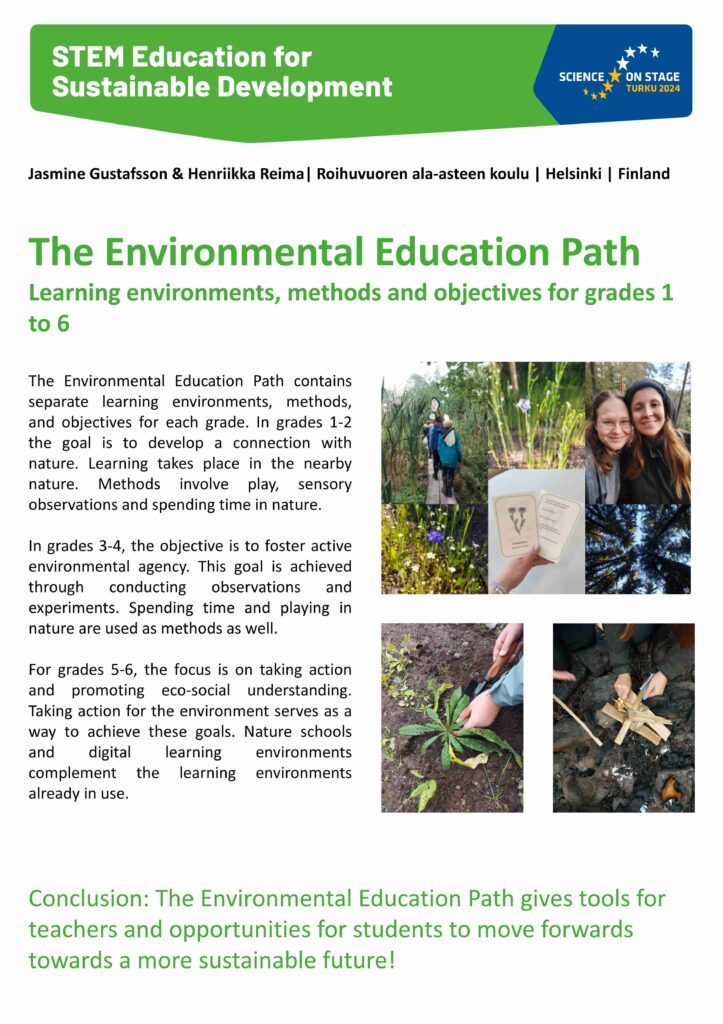
Institution: Roihuvuoren ala-asteen koulu
Subjects: Science
In the Environmental Education Path, there are separate learning environments, methods and objectives for each grade. In grades 1-2, the goal is to develop a connection with nature. Learning takes place in the nearby nature. Methods involve play, sensory observations and spending time in nature. In grades 3-4, the objective is to foster active environmental agency. This goal is achieved through conducting observations and experiments. For grades 5-6, the focus is on taking action and promoting eco-social understanding. Taking action for the environment serves as a way to achieve these goals. Nature schools and digital learning environments complement the learning environments already in use.
(S15) Flora -Tech, K. Jaupi (AL)
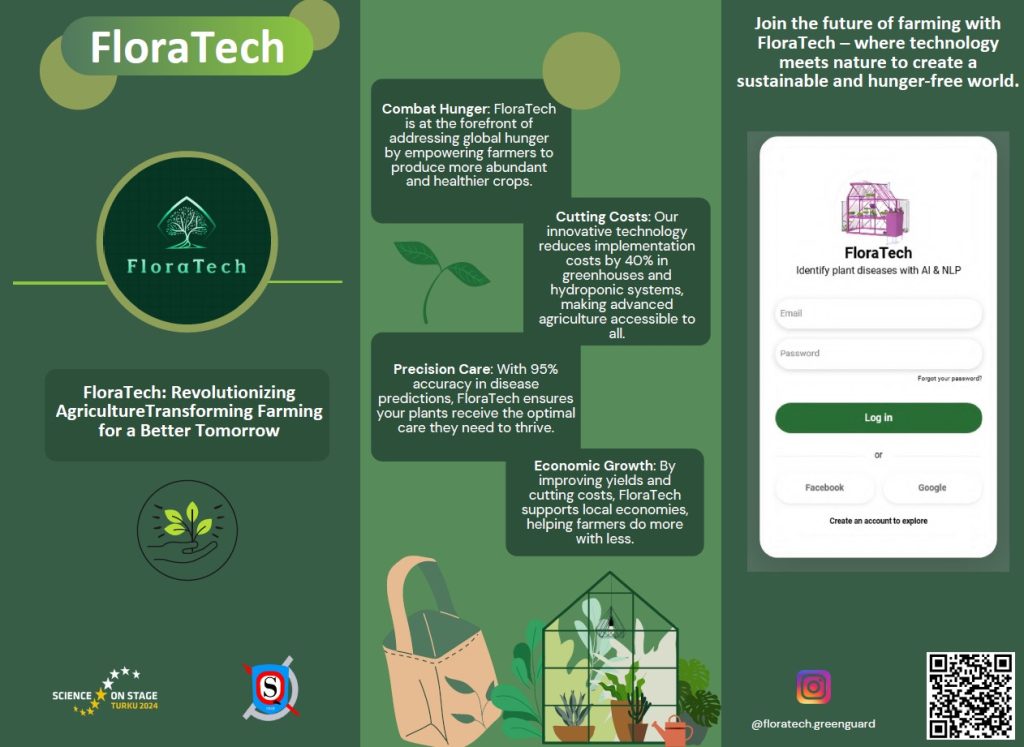
Institution: ‘Qemal Stafa’ High School, Tirana
Subjects: Physics, biology, chemistry, mathematics, computer science/ICT/IT, foreing languages, arts and design
Floratech is a groundbreaking project that employs AI to identify plant diseases in their initial stages, thereby averting food wastage and providing the most effective treatment methods. The data gathered is utilized to comprehend the requirements of the plants, which in turn controls an automatic care system. This system manages watering, light, and mineral distribution in greenhouses. The machine’s user-friendly interface is delivered to the user in the form of an app and web application, making it easily accessible. This innovative technology is set to revolutionize plant care by making it more efficient and effective, thereby contributing to sustainable agriculture practices.
(S16) Foot by foot, M. Maia-Mendes (PT)

Institution: Agrupamento de Escolas de Ermesinde
Subjects: Biology, science, ecology, environmental education, art
“Foot By Foot” introduces children to the captivating world of animal footprints emphasizing the stories they tell. It begins with an overview of the valuable information that can be gleaned from simple animal footprints, such as species identification, behavior and habitat details. The primary objectives are to familiarize children with animal footprints, encourage critical thinking, and hone their observation skills. This comprises various components, including an engaging discussion about animal footprints, their significance, and why they matter. A hands-on activity helps children understand the uniqueness of animal prints and use “Pegadoscópio” and dichotomous keys for identification.
(S17) Climate physics with ice-cold experiments, F. Ebert & U. Jeschke (DE)

Institution: Agrupamento de Escolas de Ermesinde
Subjects: Physics, mathematics, geography
When you hear climate change, the first thing that comes to mind is the greenhouse effect. But is that enough? Glaciers and sea ice in particular are not only the first victims but also important players in the climate system. In 7 experiments, learners experience what the disappearance of Arctic sea ice has to do with the salt content in the North Atlantic and that tipping points do not only occur during tipping.
Along the way, they learn why it is so cold at the North Pole, how snow is responsible that it stays that way and why melting ice floes do not cause the sea level to rise.
In short: Even slight adjustments of a complex system can have dramatic consequences.
(S19) Global Goals for sustainable development, O. H. Christensen (DK)

Institution: VIA CFU
Subjects: Science
Verdensmål.nu contains free teaching aides for the natural sciences for teaching the UN’s 17 Global Goals for sustainable development related to the students’ own world.
Verdensmål.nu consists of three student books targeted at grades 1-3, 4-6 and 7-9 class, associated teacher guides, as well as the learning site verdensmål.nu and dr.dk/skole.
Verdensmål.nu contains short student texts pedagogically adapted for the target group with current and practically oriented tasks, as well as short films and TV clips. Student books and teacher guides include links to films and TV clips, and as a flip book for presentation.
(S20) Good Vibrations, G. Gasparini & M. E. Lai (IT)

Institution: “A. Volta” – IC Cornigliano
Subjects: Technology, science
The Good Vibrations project involves the use of piezoelectric phenomenon as innovative solutions for energy production and storage. After analysing the school and neighbourhood context, we created two realistic models, piezoelectric step and bump, by placing the circuit inside the MDF panel. The copper wires were connected to the capacitor, which was charged by them, transforming the vibrational energy into electrical energy transferred to the LEDs when necessary. The staircase made up of piezoelectric steps is illuminated by the energy produced thanks to movement. The piezoelectric bump self-produces energy for light signalling thanks to the movement of cars contributing also to road safety.
(S21) Green Architecture, A. Mustać (HR)
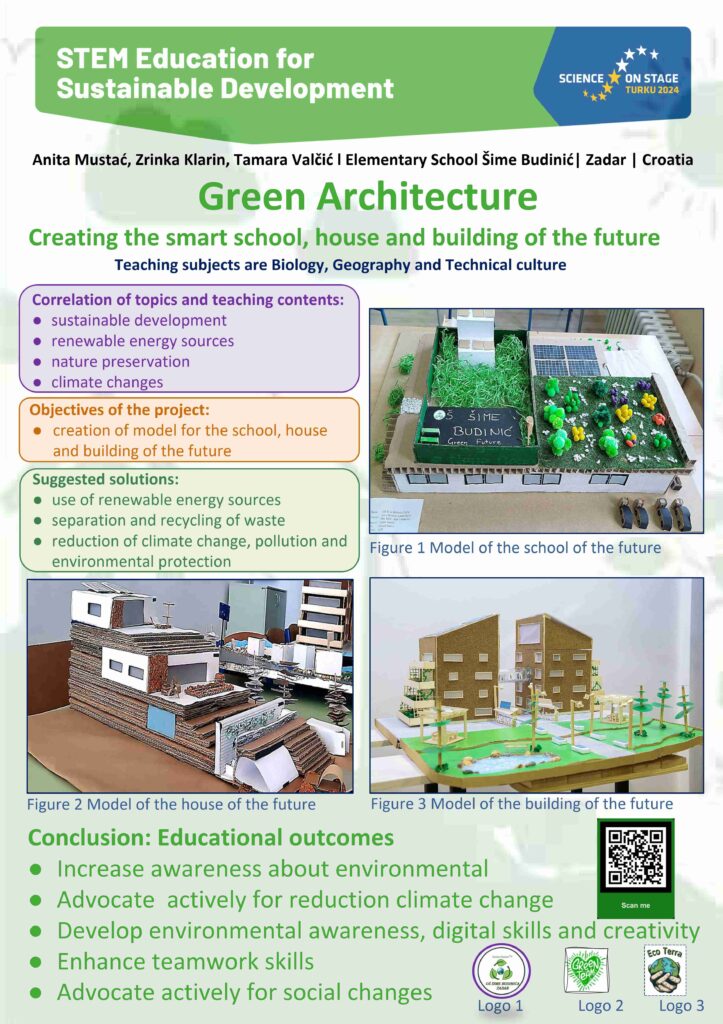
Institution: Elementary School Šime Budinić
Subjects: Biology, geography, technical culture
The aim of the project is to raise awareness among pupils about the problems caused by climate change, environmental pollution, and the consumption of natural resources. The aim of the activity is to develop a model of a sustainable building in a sustainable city that encourages the use of renewable energy sources, saves water and energy, separates and recycles waste, and contributes to the reduction of climate change and pollution. By participating in the project, pupils actively advocate for social change, develop creativity, motor and digital skills, and teamwork. The project is a collaboration between STEM subjects – biology, geography, and technical culture.
(S22) Green Energy from Water, D. Nikolova & K. Tomeva (BG)

Institution: Vocational High School of Mechanical Electritechnics /VHSME/ Gen. Ivan Bachvarov
Subjects: Chemistry, engineering
The “Green Energy from Water” project presents an idea for a sustainable green future. It was developed by a chemistry teacher and an engineering teacher. It concerns the hydrogen economy as an ecological economy and includes various hydrogen production experiments and fuel cell experiments.
The aim of the project is to demonstrate the use of the electrolysis process as an opportunity to obtain hydrogen and convert chemical energy into electrical energy.
The topic can find a place in science and ecology classes, electrical engineering and in extracurricular forms of learning, spark interest and give ideas for future projects.
(S23) Endangered Oceans – Experimental Teaching Units on Climate Change, A. Schautz, D. Evers & T. Klaffs (DE)

Institution: Bodenstedt-Wilhelmschule-Peine & phaeno Science Center & Ratsgymnasium Peine
Subjects: Physics, biology, chemistry, geography, ethics
The earth is increasingly influenced by the effects of global warming and environmental pollution. Our series “Riff-Geschichten” (reef stories) deals with the consequences for oceans in particular: In seven short stories, we take a deep dive into a colourful reef made of crocheted anemones, fish and other protagonists. The stories provide important insights into topics like ocean currents and their influence on the climate, marine inhabitants in their ecosystems, specific climate related threads and tipping points. Extensive teaching material, including experiments and work sheets, complements every short story offering an easy way to be used in class, projects or study groups.
(S24) Magnificent Moss, R. Edmondson (UK)
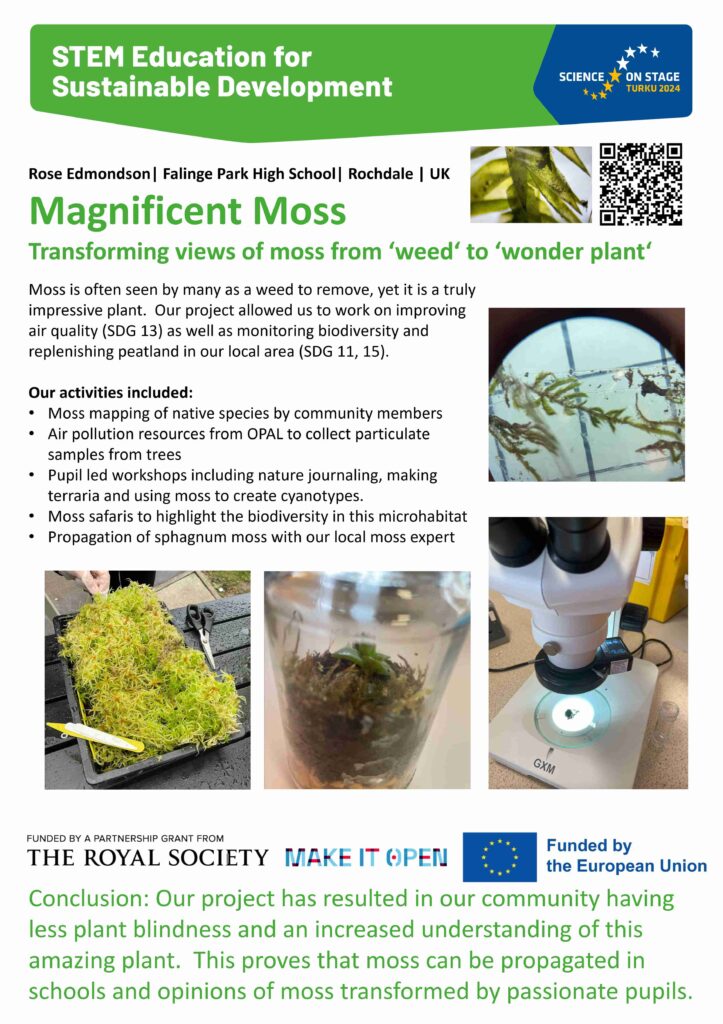
Institution: Falinge Park High School
Subjects: Biology, mathematics, technology, science, geography, environmental science
Moss is often seen as something to get rid of, but it’s unbelievably fascinating and should be celebrated all over the world. Our project involves a sequence of learning scenarios where pupils get close to moss, mapping where moss is located around the school site as well as collecting data about air pollution. Students then undertake moss safaris to investigate its role in pollution capture as well as it being a fascinating microhabitat. Students design and deliver workshops to construct terrariums, create kokedamas and share how moss can be used in a sustainable way and why it needs not only to be protected but also to be celebrated around the world.
(S25) How to deal with sand? Literature through science, A. Omarkhanova (KZ)

Institution: Nazarbayev Intellectual School of Chemical and Biological Directions in Almaty
Subjects: Physics, biology, art
The project, combining technology and humanities, aims to encourage teachers and students to reconsider their attitudes towards climate change issues not only in their region, but also in the global community. Going beyond STEM education, we offer a new educational tool to transform students’ XXI century skills. Based on the story “The Sand Teacher” by A. Platonov, students used the experience of Maria, the main character of the story, to transform the world and build a new life on the border with the Central Asian desert. We studied how to ensure and protect human life from global climate change. We propose two methods to combat the spread of sand to improve the environment and quality of life.
(S26) How to love nature and why, H. Jashari (MK)

Institution: Ismail Qemali; Simche Nastovski
Subjects: Computer science/ICT/IT, science, art, ecology, communication culture
The realisation of this project is based on: Learning based on projects. Learning based on solving problems; Outdoor learning; Formation of leadership for the protection of the living environment; Connection of nature and the use of technology
This project aims to involve students in projects based on real problems that require engineering solutions, using relevant social, environmental, or technical challenges to help students see the importance of coding (technology), engineering, and biodiversity conservation in solving real-world problems.
The project’s main goal was to include SDG objectives.
(S27) Is the lettuce salad breathing inside your fridge? K. Chalkiadakis (GR)

Institution: 1st Laboratory Centre of Physical Sciences of Rethymnon
Subjects: Physics, biology
The increase of atmospheric CO2 is considered to be a significant factor in climate change. Thus, the presentation of educational activities related to the cycle of carbon dioxide is crucial. This work presents an arrangement for measuring CO2 concentration in the air that consists of two parts. The first part is a CO2 sensor with a microcontroller that transmits the data collected via Bluetooth. The receiver is a mobile device with the Phyphox app installed. This low-cost device can display real-time changes in concentration as a graph over time. It can be used for investigating respiration and photosynthesis of plants, the relationship between light wavelength and photosynthesis etc.
(S28) Lunar Odyssey, D. Łubieńska (PL)
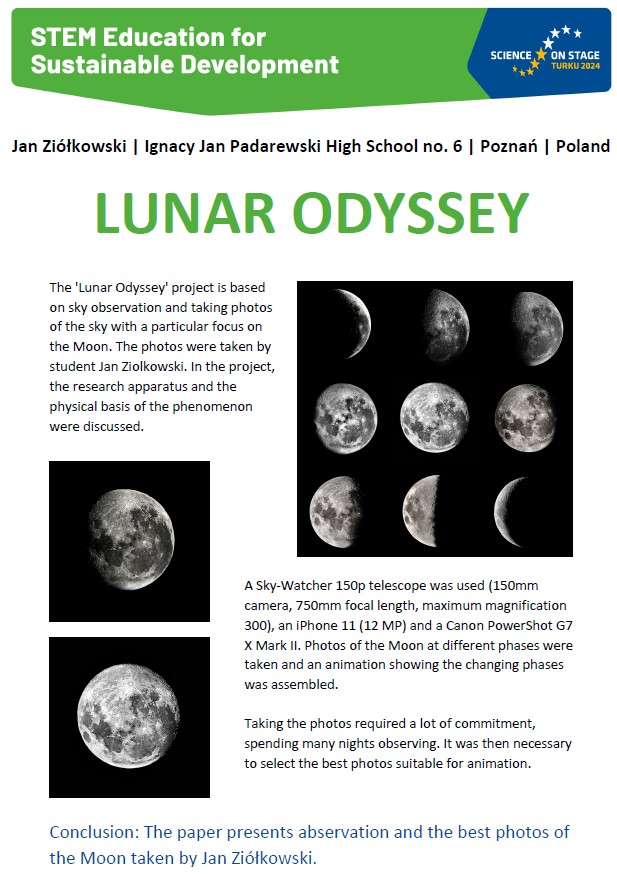
Institution: Ignacy Jan Padarewski High School no. 6 in Leszno
Subjects: Physics, astronomy
The ‘Lunar Odyssey’ project is based on sky observation and taking photos of the sky with a particular focus on the Moon. The photos were taken by student Jan Ziolkowski. In the project, the research apparatus and the physical basis of the phenomenon were discussed. A Sky-Watcher 150p telescope was used (150mm camera, 750mm focal length, maximum magnification 300) , an iPhone 11 (12 MP) and a Canon PowerShot G7 X Mark II. Photos of the Moon at different phases were taken and an animation showing the changing phases was assembled. Taking the photos required a lot of commitment, spending many nights observing. It was then necessary to select the best photos suitable for animation.
(S29) Many different rays! Causes and consequences of Global Warming? S. Brütsch (CH)
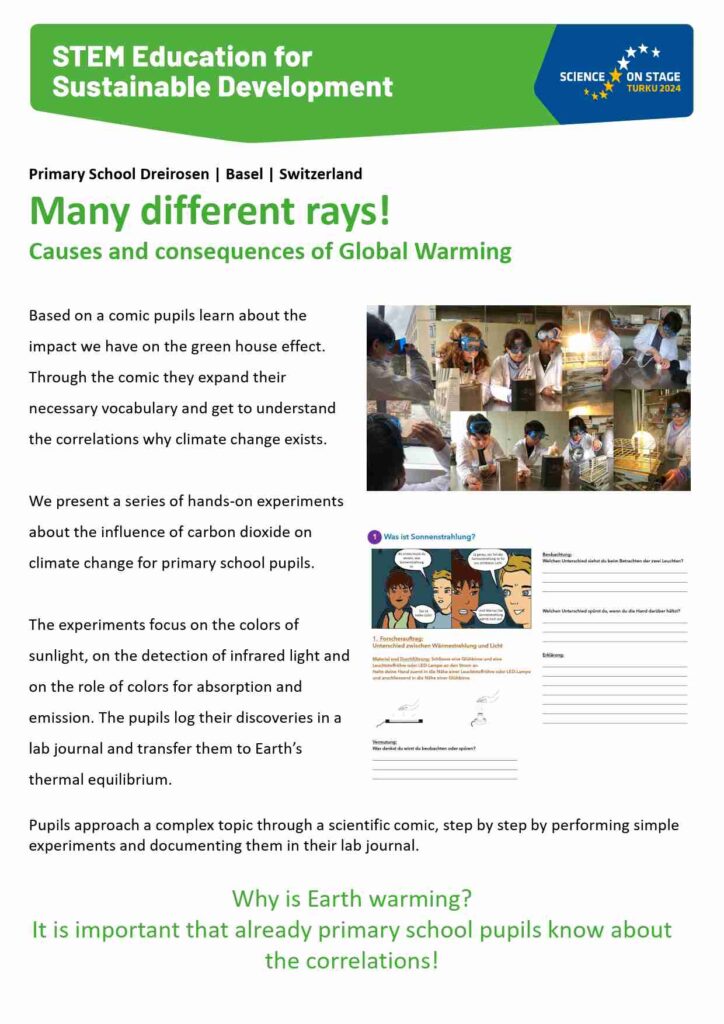
Institution: PS Dreirosen
Subjects: STEAM
Based on a comic the pupils learn about the impact we have as human beings on the green house effect. Through the comic they build a necessary vocablurary and get to understand the correlations why climate change exists.
We present a series of hands-on experiments about the influence of carbon dioxide on climate change for primary school pupils. The experiments focus on the colors of sun light, on the detection of infrared light and on the role of colors for absorption and emission. The pupils log their discoveries in lab journal and transfer them to earth’s thermal equilibrium.
(S30) My Doubly Ecological Wind Turbine, M. Mesmoudi (FR)
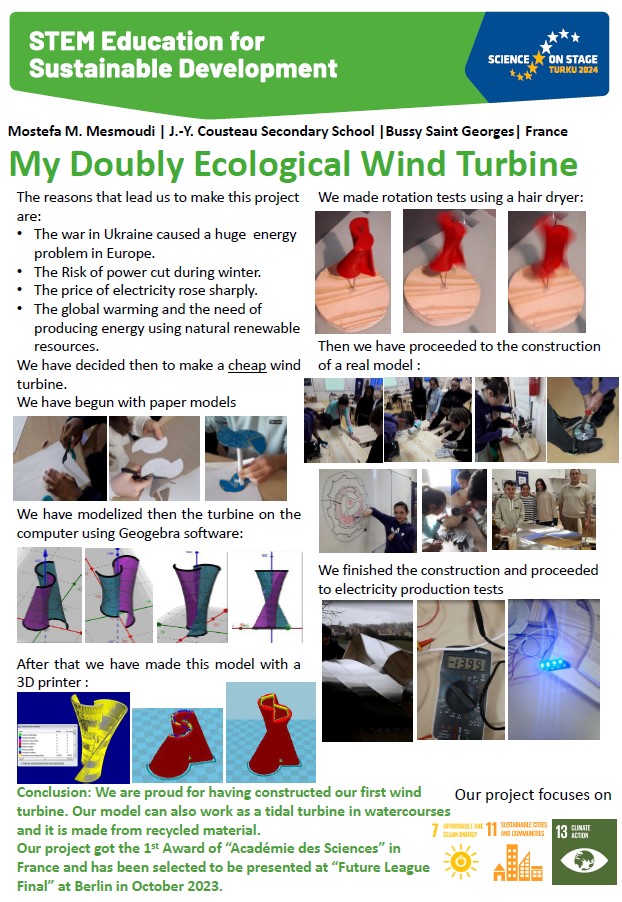
Institution: J.-Y. Cousteau
Subjects: Physics, biology, mathematics, arts
Crises provide breeding ground for innovation. At a time when the cost of energy is exploding and global warming is increasing, the goal of this project was to raise students’ awareness of the energy and ecological problems of our era. We were interested in the ecological production of electricity which mobilizes natural and renewable resources such as wind. Our study led students to make a cheap wind and tidal turbine from recycled materials and test its production. The shape of the wind turbine is artistic and inspired by the structure of DANN. The wind turbine that the students made can be reproduced by anyone who wants to produce clean energy that meets part of their daily needs.
(S31) Plant an Emotion, N. Psuturi (GE)

Institution: LEPL Gori public school #8
Subjects: Biology
Seventh and ninth graders collaborated on the Plant an emotion project. Ninth graders, from the startup Herba, create plantable paper holiday cards with embedded flower seeds. Seventh graders, exploring life cycles, joined the project to observe seed growth. Together, they conducted experiments, raising questions about optimal conditions to grow a plant. The outcome: a board game, Researching with Sheldon, making learning enjoyable and informative.
(S32) Power Heroes, M. Özer (TR)
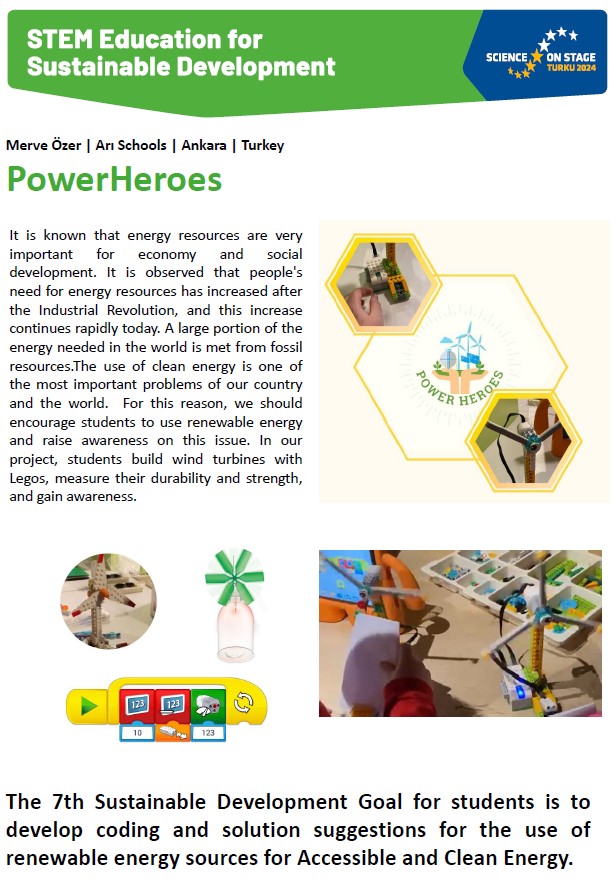
Institution: Ari Schools
Subjects: Computer science/ICT/IT, science
It is known that energy resources are very important for economical and social development. It is observed that people’s need for energy resources has increased after the industrial revolution, and this increase continues rapidly today. A large portion of the energy needed in the world comes from fossil resources. It is known that the consumption of fossil resources causes great harm to nature. The aim of the Power Heroes project is to provide students with coding solutions for the use of renewable energy sources for the 7th of the Sustainable Development Goals, Affordable and Clean Energy.
(S33) Radioactivity around us, A. Blahák & J. Růžička (CZ)

Institution: Gymnázium J. G. Mendela / VIDA! Science center & Moravian Science Centre Brno, příspěvková organizace
Subjects: Physics, chemistry
We are going to focus on radioactivity education for secondary schools. My education project merges hands-on and tech learning. Students build DIY cloud chambers, learn with a particle camera, explore models and experiment. The constructivist approach covers the basics, effects, and applications of radioactivity. They measure the radioactivity of objects and grasp safe dose concepts. Most of the activities are part of the education program in the science center but some of them I am successfully using during my teaching in secondary school.
(S34) Recicl@PET, N. Lança (PT)

Institution: Agrupamento de Escolas Pedro Eanes Lobato
Subjects: Physics, chemistry
PET plastic is used on a daily basis in the most varied of human activities, particularly in liquid containers for water and carbonated beverages, but is not always properly recycled. The Recicl@PET project aims to promote the recycling of this valuable resource in the school setting, by spiralizing bottles into filament adequate for commercially available 3D printers (process called pultrusion). Many PET pultrusion projects have been developed by the maker community worldwide, notably Joshua Taylor’s Recreator3D. Another noteworthy project is the PETamentor, developed by Ondřej Šraitr; a much simpler pultrusion machine that is quite interesting as a school project.
(S35) Replacing Plastics: An investigation into creating natural polymers, C. Reesink-Wells (UK)
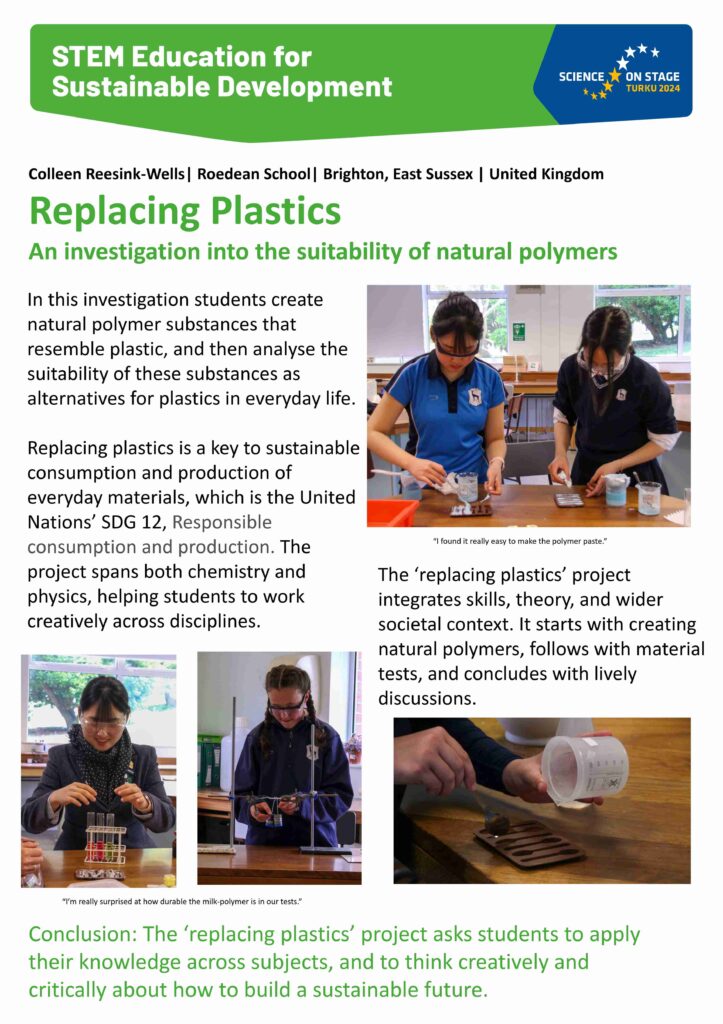
Institution: Holy Trinity C of E
Subjects: Chemistry, technology, material science, environmental science, design, business studies
This project outlines an activity in which students create a natural polymer substance that resembles plastic. Whereas plastics are made from crude oil, this polymer is synthesised from milk using readily available materials and techniques. Replacing plastics is a key to sustainable consumption and production of everyday materials, which is the United Nations’ Sustainable Development Goal 12. The product, mould-casted polymer objects, can be compared against regular plastics and used to incite discussion about the nature and role of plastics in our society.
(S36) SAVE NATURE – Circular Economy, A. Zhekova & S. Tsonkova (BG)

Institution: Sredno uchilishte Vasil Levski
Subjects: Computer science/ICT/IT, science, english, ecology & nature studies, art & design
“SAVE NATURE – Circular Economy” is a project developed as an extra-curricular activity with students aged 16. The topic and all the activities were initiated by the students. They focused on introducing the idea of circular economy to other students by designing an information poster explaining the 5 Rs and a game based on Monopoly – Eco-Monopoly. Working on the project they applied knowledge from different school subjects – ICT, biology, chemistry, ecology, English and geography. The students developed a number of skills: teamwork, research, synthesis, information processing and public speaking. A number of online tools were used: YouTube, Kahoot!, video editor, QR code creators.
(S37) Save the World! An Escape Room on Climate Change and Sustainability, A. Pomoell & S. Enestam (FI)

Institution: Kyrkslätts gymnasium & Skolresurs
Subjects: Physics, chemistry, mathematics, sustainability
“Save the World!” is an Escape Room, where the students solve tasks designed to develop knowledge in ecological sustainability, raising awareness of our limited raw materials, sustainable use of resources and mathematical problem-solving. “Save the World!” differs from many other Escape Rooms as the entire class collaborate, making the class resemble a miniature society. As a reward for solving a task, they receive trees placed on a balance scale, but at the same time, fossil fuels act as a counterbalance. The Escape Room also includes examples of development projects from the Finnish industry. We hope that the good side of the scale has tipped in the right direction before time runs out!
(S39) SDG – Park Race, K. Blake & M. Smolka (DE)

Institution: Gymnasium München-Moosach
Subjects: Physics, biology, chemistry, mathematics, geography, humanities, political science, linguistics
The interdisciplinary project SDG-Park Race consists of 10 practical modules on the goals for sustainable development and serves as a collection of methods for implementing the 17 SDGs. The focus is on practical scientific knowledge gain starting from an everyday problem. Due to the modular structure, this project can be individually adapted to e.g. an excursion, a project day or a lesson. The project was carried out at Olympic Park Munich, where students examined various aspects of the park. In doing so, the development of competencies that are important for coping with the social challenges of sustainable development is promoted through differentiated and age-appropriate material.
(S40) Smart venetian blinds, V. Stepanovska-Andonova (MK)

Institution: Primary School “Dame Gruev”
Subjects: Physics, technology
Since almost every institution of a public nature uses venetian blinds, there is a sensible way to make smart venetian blinds with a suitable superstructure on larger existing ones. This will consist primarily of the use of solar energy through the installation of solar cells on the outer sides of the venetian blinds, which would be stored and converted into electrical energy through solar batteries. On the inside, on the other hand, LEDs are installed, which would convert the electrical energy into light energy, which is necessary for the internal lighting of the home. It will also mean that electricity will be obtained to power some electronic devices that use a lower voltage.
(S41) Plastic VS Plant, T. Turashvili (GE)

Institution: Georgian-English-Spanish school AIA-GESS
Subjects: Biology, chemistry, computer science/ICT/IT, technology
The project Plastic VS Plant is focused on the following goals of sustainable development: responsible consumption and production, climate actions. 8th grade students participated in it. They investigated the role of plants in the process of climate change. The emissions produced by the burning of plastic have a negative effect on the plant, causing a change in temperature and humidity in the environment, an increase in acidity, at the same time the plant absorbs harmful gases and after some time regulates the temperature in the environment, thus preventing the accumulation of greenhouse gases.
Students actively continue to care for the environment. Big changes start with small steps!
(S42) Solar tree – How to improve a photovoltaic panel using biomimicry, G. Hennemann & P. Mancini (FR)

Institution: Collège Louis Clément
Subjects: Physics, biology, chemistry, mathematics, technology
Pupils study how to improve a photovoltaic panel using nature as inspiration. They adopt a transversal approach to science and learn about sustainable development.
Pupils create a solar tree whose leaves are replaced by photovoltaic cells and compare its performance with a classic flat solar panel. They show that a solar tree can be a better effective solution using solar panels to achieve the SDG goals. Pupils adopt the following approach across several disciplines (biology,chemistry,physics,mathematics,technology):
- Show the light energy needs of plants and how they optimize light reception
- Studying photovoltaic cells
- Manufacture photovoltaic panels
- Measure performance and analyze data
(S43) STEM & ART, V. Bacsó (HU)

Institution: Medgyessy Ferenc Gimnázium, Muvészeti Szakgimnázium és Technikum
Subjects: Technology, engineering
One of my students was 17 years old when her scientific achievements put her on the TED stage in 2023. But how does a 17-year-old student get on the TED stage? Thanks to a lot of work, dedecation and a science talent development programme I launched at our school in 2017. Our activities involve making simple sensing devices to solve everyday problems, keeping in mind the 17 recommendations of the UN. We pose a problem to the students. They brainstorm problems to solve and then implement their ideas by carrying out engineering design and construction tasks. The programme develops students’ thinking, problem-solving skills, creativity and interest in science careers.
(S44) Sustainability of everyday chemicals, M. Jonsson (SE)

Institution: Procivitas Uppsala
Subjects: Chemistry
This is a chemistry project where, for a few weeks, students will find and present chemistry that they have found in everyday life. The students will then place these molecules where they should end up in the biosphere based on their chemical properties. This is then followed by a discussion about the problems with mishandling and recycling of chemicals as well as the societal benefits of chemistry based on the agenda 2030. The project ends with a laboratory with the theme of substitution, where the students create bioplastics from starch.
(S45) Sustainable future – Course for upper secondary school students, T. Hakkarainen & P. Kuokka (FI)

Institution: Helsinki School of Natural Sciences
Subjects: Physics, biology, chemistry, geography, music, psychology, philosophy
Sustainable Future is a course organised in the Helsinki School of Natural Sciences for upper secondary school students. The course includes lectures, workshops, and visits, and there is a possibility to do a project and also to participate in a field trip to Hyytiälä forest station (University of Helsinki) in Juupajoki. The themes of the course are energy, biodiversity, sustainable food, new materials, water, carbon cycle, interpreting atmospheric data, environmental emotions and environmental activism. The course is 1-3 ects and the students can choose an emphasis on natural or social sciences. The course is organised by teachers from natural science, social science and arts backgrounds.
(S46) The Castle’s Guesthouse and Solar System in an Albanian Podcast, V. Ismaili (AL)

Institution: Sule Harri
Subjects: Computer science/ICT/IT, STEM
A symbiosis of tradition and technology, the castle smart inn project represents a harmonious blend of tradition and technology, where the ancient meets the modern. By integrating these innovative features, the guesthouse not only offers a unique and comprehensive experience for visitors, but also contributes to the preservation of Elbasan Castle for generations to come.
We wanted to explain the concepts of geocentric, heliocentric and eclipse systems in a simple and understandable way. I choose Unity as a development environment, the C# programming language and Visual Studio to program the movements and actions of the planets and the sun based on their theories and eclipses.
(S47) The Climate Game, G. Şeref (TR)

Institution: Prof. Dr. Şaban Teoman Duralı Science and Art Center
Subjects: Mathematics, computer science/ICT/IT, technology, science, design
Climate change is one of the most important global environmental problems of the century. If we do not take the necessary measures, we will lose the world we live in with irreversible consequences for us in the future. For this reason, determining the knowledge and awareness levels of individuals, especially children – tomorrow’s adults – based on the proverb “A tree bends while it is young”, will contribute to the solution of the problem. The research aims to determine the knowledge levels of secondary school students about the causes and effects of climate change and the fight against it. It was aimed to investigate the effect of games by designing a box game to increase their awareness.
(S48) The first step, E. Lempesi & V. Michalopoulos (GR)

Institution: Bougas School
Subjects: Physics, computer science/ICT/IT, science
The project “The first step” is a staircase with a movable upper part. Each time we step on it, the movable part descends a few centimeters and compresses an air pump. So, every time we step on the staircase, air is expelled from the pump and rotates a turbine integrated into the axis of a generator. The rotation of the axis produces energy, capable of lighting some LEDs. In this way, we manage to illuminate the LEDs and light up the staircase without the need of a power company. Instead of using the corridor switch in an apartment building and turning on all the lights, we could step on a movable step and illuminate the next ones so that we can see where we are stepping.
(S49) The GLOBE program and sustainable development, L. Javoršek (SI)
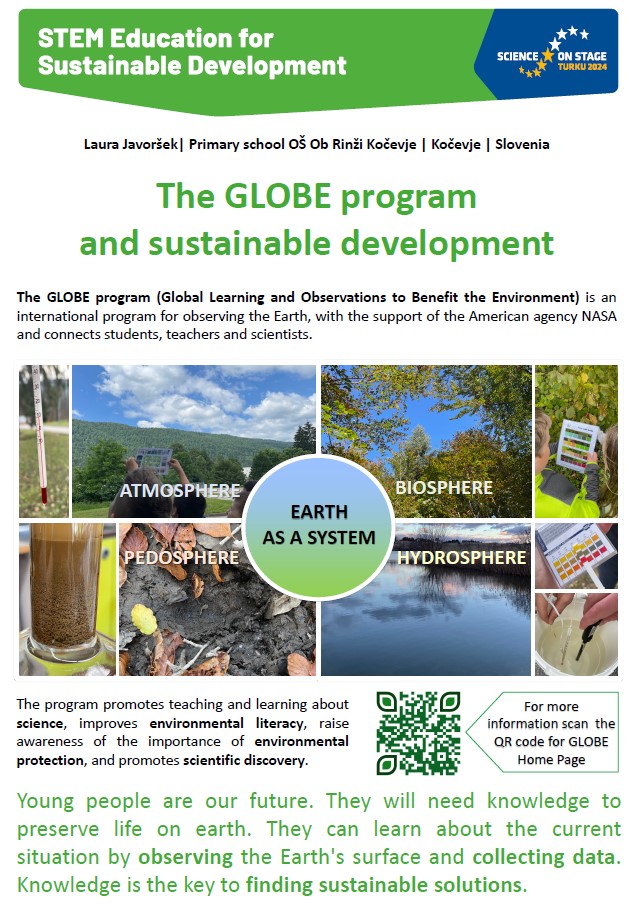
Institution: Osnovna šola Ob Rinži Kocevje
Subjects: Physics, biology, chemistry
The GLOBE program (Global Learning and Observations to Benefit the Environment) is an international program for observing the Earth, which takes place under the auspices of the NASA and connects students, teachers and scientists. The program promotes teaching and learning about science, improves environmental literacy, raises awareness of the importance of environmental protection, and promotes scientific discovery. The program encompasses protocols related to the atmosphere, the hydrosphere, the biosphere, the pedosphere and the Earth as a system. It includes all seventeen Sustainable Development Goals. The collected data form na important database for further research.
(S50) Thermal electric current generator, I. Iwaszkiewicz-Kostka & M. Nowak (PL)

Institution: Ród Leszczyńskich High School & Romek Strzałkowski High School & Adam Mickiewicz University
Subjects: Physics
The main goal of our project was to build a thermal electric current generator. For this purpose, we needed: a water cooler (2 pcs), a water pump, a Peltier cell (6 pcs), a heat sink (2 pcs) and some parts to prepare the structure (mainly plywood, threaded rods, nuts, washers). One of the key elements was the Peltier cell, which is a semiconductor element made of two thin plates. The Seebeck effect occurs in the cells we use, which involves generating electric current in a circuit composed of two different metals or semiconductors when their junctions are at different temperatures. Through heat sinks, we heat one side of the cells with burning candles, and cool the other side with ice water.
(S51) Transformation of Waste into STEAM Resources, O. Okulova (UA)

Institution: Ivano – Frankove secondary school named after Ivan Franko
Subjects: Physics, biology, chemistry, mathematics, STEM, earth and environmental science
Students create projects from various waste products both according to simple instructions and schemes in form of individual and group creative projects. The project is designed to develop interest in studying STEM subjects, to form scientific thinking and design skills using the engineering design method. As part of the project, the following were created: models of airplanes and rockets with different launchers, models with an electric circuit for lighting a house or moving a car, projects using water as an energy source, models of organs and systems from secondary materials for biology lessons, models that work based on the use of wind/solar energy.
(S52) Turn the Pedal, Bring Yield to the Soil, B. Ş. Gümüş (TR)

Institution: Private Ankara Maya Secondary School
Subjects: Mathematics, computer science/ICT/IT, technology, science, design
Every year, one third of the food produced for food consumption, about 1.3 million tons, is lost before it reaches our tables. This project has been developed with the aim of utilizing this rotting and damaged food before it goes to waste. Our project includes steps such as conducting research and awareness-raising studies on food waste and soil loss, designing a compost machine (STEM study) and using the compost obtained with the designed system in growing crops. Experiment, observation and interviews from scientific research methods were used in the project. The project is an interdisciplinary study combining science, mathematics, technology and design.
(S53) Unconventional energy sources, J. Jarosz & J. Gryboś (PL)

Institution: John Paul II General Secondary School Complex & University of Silesia
Subjects: Physics, biology, chemistry, mathematics
The aim of the project was to create dye-sensitized solar cells in school conditions and to compare them with standard commercial photovoltaic panels. The principle of operation is based on the phenomenon of electron flow between electrodes, using a dye as an intermediary. The panels were tested to determine electric parameters and current-voltage characteristics. Electrically conducting glasses (ITO), titanium dioxide, graphite, chemical reagents, and natural dyes obtained from fruits and flowers were used to produce dye-colored photovoltaic cells based on biochemical processes. The project compared the efficiency of a reference cell with a dye cell to justify its practical usefulness.
(S54) Understanding The World We Live In, One Cell at a Time, J. Guay (CA)

Institution: CSSC Mercier
Subjects: Mathematics, technology, science, French, history, geography, social studies
Over the past years, the COVID-19 pandemic has opened us up to the world. Shocking disparities, inequalities in access to care, and socio-economic issues have been exposed all over the world. But how did we get there? This multidisciplinary didactic sequence puts the student at the heart of his learning and aims to highlight the characteristics of life, the different types of cells, the process of photosynthesis, the practical uses of microorganisms, the functioning of the immune system, as well as the perspectives of First Nations regarding the use of medicinal plants. This is done via manipulation, exploration, analysis, as well as the development of critical thinking and literacy skills!
(S55) Waste, fungi and compost, R. Flander (SI)

Institution: Davorin Jenko Primary School
Subjects: Biology
Households generate a lot of biodegradable waste. By processing it we can obtain compost and prevent such waste from ending up in landfills.
To find out which trash is good for compost students make an investigation about the rate of decomposition of different waste. They place each trash item (apple core, plastic, bread, aluminum foil, paper, biodegradable products made to replace plastic) into the jars. They fill them with the soil to add microorganisms for decomposition. During the 8 weeks of observation they also explain the role of decomposers and for higher motivation also grow fungi in the class.
The investigation can be expanded to explore the factors that influence decomposition.
(S56) Water is the source of life, S. Kurbardovic (MK)

Institution: Primary School “25 May”
Subjects: Biology, technology, science, environmental science, education and pedagogy, innovation
The project “Water is the Source of Life” aspires to instill environmental consciousness, nurture budding scientists, and promote sustainable practices among students. Through collaborative efforts, educational initiatives, and hands-on experiences, the project endeavors to create a generation that not only appreciates the significance of water but actively contributes to its conservation. By exploring real-world issues and engaging in solutions, students are poised to become informed advocates for the preservation of this essential resource, setting the stage for a more environmentally conscious and sustainable future.
(S57) When little hands come together, anything is possible! A. Kordić & D. Kovačević (HR)
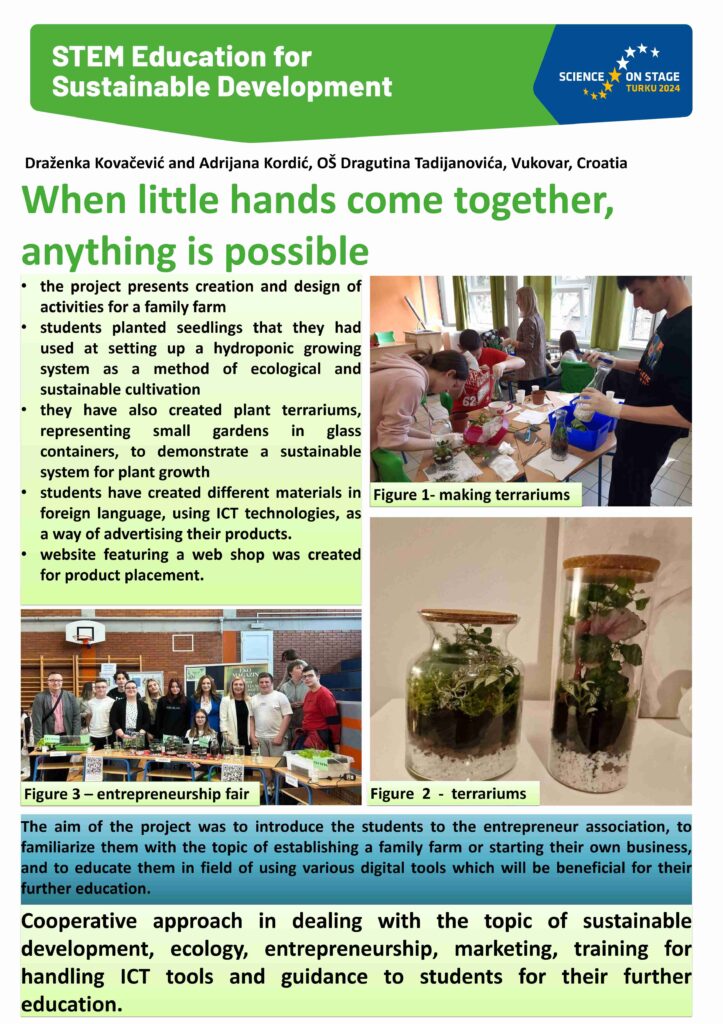
Institution: Osnovna škola Dragutina Tadijanovića
Subjects: Biology, chemistry, computer science/ICT/IT, German
‘When little hands come together, everything is possible!’ is a project created under the theme of entrepreneurship. The students had the task to establish and design an activity for their family farm. They planted seedlings and used them when setting up a system for growing plants hydroponically as methods of ecological and sustainable cultivation. They also made plant terrariums, mini gardens in glass containers. They created a cover page of the magazine “Eco-magazine” that implements sustainable development and innovative cultivation methods, bilingual plant development, advertisement in German language, all made with digital tools. For product placement they created a website with a web shop.
